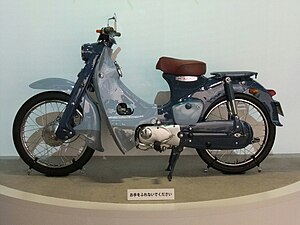Honda 50

Honda Super Cub in the Honda Collection Hall in Japan
|
|
| Also called | Cub, C100, C102, C65, CM90, CM91, C110, C50, C70, C90, Passport, EX5, Dream 100, EX5 Dream, C100EX, Super Cub 50, Super Cub 110 |
|---|---|
| Production | Since 1958 |
| Assembly | 15 countries worldwide |
| Class | Underbone |
| Engine | Horizontal 49–109 cc (3.0–6.7 cu in) 4-stroke air-cooled single |
| Transmission | 3 or 4 speed, semi-automatic with wet multi-plate centrifugal clutch |
| Frame type | Step through pressed steel monocoque underbone |
| Suspension | Front: Leading link (early), telescopic fork (late) Rear: Swingarm |
| Brakes | Front: drum rear: drum |
| Weight | 55–90 kg (121–198 lb) (dry) |
| Manufacturer | SYM Motors |
|---|---|
| Also called | Symba 110 |
| Assembly | Taiwan |
| Engine | 101.4 cc (6.19 cu in) air cooled four stroke OHV single |
| Compression ratio | 9.6:1 |
| Top speed | 90 km/h (56 mph) (claimed) |
| Power | 4.8 kW (6.5 hp) at 8500 rpm |
| Torque | 6.8 N·m (5 lb·ft) at 8500 rpm |
| Transmission | Wet multi-plate clutch, 4 speed semi-automatic |
| Frame type | Pressed steel underbone |
| Suspension | Front: telescopic fork, rear: swingarm |
| Brakes | Front: 130 mm (5.1 in), rear: 110 mm (4.3 in) |
| Tires | Front and rear: 2.50-17" |
| Wheelbase | 1,225 mm (48.22 in) |
| Dimensions |
L: 1,900 mm (75 in) W: 690 mm (27 in) H: 1,000 mm (41 in) |
| Seat height | 760 mm (29.9 in) |
| Weight | 95 kg (209 lb) (claimed) (wet) |
| Fuel capacity | 1.08 US gal (4.1 l; 0.90 imp gal) |
The Honda Super Cub is a Honda underbone motorcycle with a four stroke single cylinder engine ranging in displacement from 49 to 109 cc (3.0 to 6.7 cu in).
In continuous manufacture since 1958 with production surpassing 60 million in 2008, and 87 million in 2014, the Super Cub is the most produced motor vehicle in history. Variants include the C100, C50, C70, C90, C100EX and C70 Passport.
The Super Cub's US advertising campaign, You meet the nicest people on a Honda, had a lasting impact on Honda's image and on American attitudes to motorcycling, and is often used as a marketing case study.
The idea for a new 50-cubic-centimetre (3.1 cu in) motorcycle was conceived in 1956, when Honda Motor's Soichiro Honda and Takeo Fujisawa toured Germany and witnessed the popularity of mopeds and lightweight motorcycles. Soichiro Honda was primarily the engineering and production leader of the company, always with an eye towards winning on the racetrack, while his close partner Fujisawa was the man of finance and business, heading up sales and formulating strategies intended to dominate markets and utterly destroy Honda Motor's competitors. Fujisawa had been thinking about a long term expansion strategy, and unlike other Japanese companies, they did not want to simply boost production to cash in on the recent economic boom in Japan. A small, high-performance motorcycle was central to his plans. Upwardly mobile consumers in postwar Europe typically went from a bicycle to a clip on engine, then bought a scooter, then a bubble car, and then a small car and onwards. Fujisawa saw that a motorcycle did not fit in this pattern for the average person, and he saw an opportunity to change that. Soichiro Honda was at the time tired of listening to Fujisawa talk about his new motorcycle idea; Honda came to Europe to win the Isle of Man TT race and wanted to think about little else.
...
Wikipedia

